Taking it Online
October 1, 2020 | 8 min to read
In January, Publix Super Markets collaborated with Instacart to test its new Instacart Meals program, allowing customers to create custom subs online without visiting stores. The program expanded to all locations by July, enabling same-day delivery and pickup of groceries. Online food sales are projected to reach $143 billion by 2025, as trends shift towards e-commerce for both perishables and dry goods. Retailers are adapting by offering pre-cut items and enhancing user-friendly platforms.

Fancy one of the signature deli subs from Publix Super Markets? Maybe it’s a chunky tuna or chicken salad or made with Boar’s Head ham. Either way, there’s no need to take a number and wait in line at the service counter or to even step foot in-store. In January, the 1,200-plus store chain headquartered in Lakeland, FL, partnered with San Francisco-based Instacart to test the online grocers’ new Instacart Meals program starting with Publix’s subs. Instacart’s digital deli counter’s ‘Build your Own’ and Smart Cart Combo features enabled online shoppers to custom build their Pub Subs with infinite combinations, plus take advantage of the retailer’s money-saving sub combos. By July, Publix had completed the program’s roll-out to all its stores across seven Southeast states. This means it’s now possible for customers to enjoy same-day delivery or pick up of perishable and non-perishable products alike.
Publix isn’t the only big name retailer to embrace e-commerce. Soon, if not already, grocery shopping electronically via the Internet will become the new norm in the supermarket deli.
“We have seen online sales significantly accelerate and increase to 30% over the last several months during the pandemic, while this level of growth was formerly predicted to happen over four to five years,” says Denise LaBrie, sales team lead for deli at the Tillamook County Creamery Association, a cheese and dairy products producer based in Tillamook, OR. “Not only have online purchases of dry goods increased, but perishables have increased along with it. Previously, it was predicted that perishables would remain as more of an in-store purchase. However, we’re seeing that the complete order is being submitted online, and retailers are needing to figure out how to make that work. What’s more, many shoppers who have transitioned to digital are saying they will continue to stay online.”
Indeed, online food and beverage sales are forecast to reach $143 billion by 2025, or 30% of all omnichannel food and beverage spending, according to a February 2020-released report from Arlington, VA-based FMI — The Food Industry Association and Chicago-headquartered Nielsen.
Here are eight ways deli operators can successfully embrace e-commerce:
1. CREATE A USER-FRIENDLY PLATFORM
Merchandising online starts with the same thought process as in-store merchandising, says Sharon Olson, president of Chicago-based food-focused marketing company, Olson Communications. “Consider the customers’ point of view and how they like to shop, what will entice them and make it easy for them to shop online.”
Also, treat e-commerce and online sales as strategic parts of retail sales, adds Umberto Marconi, vice president of Pomi USA, Inc., an Italian tomato products producer based in Matawan, NJ. “This is the first step to meeting consumer demands.”
2. CONSIDER WHAT SELLS BEST
Pre-cut rather than sliced-to-order products as well as those that feed into the pandemic-era trend of greater at-home cooking are ideal deli items to sell online.
“Sales of smaller retail cut cheeses are booming compared to large blocks,” says Joe Widmer, owner and third-generation cheesemaker at Widmer’s Cheese Cellars, in Theresa, WI. “We were just about to start selling a 10-pound size of our green olive and jalapeño brick cheese spreads, but with the drop in foodservice sales, we’ve switched instead to 8-ounce containers for retail sold 12 to a case.”
Similarly, online purchases of prosciutto are up, says Jason Stemm, the New York-based marketing representative for the Consorzio del Prosciutto de Parma, headquartered in Parma, Italy. “For pre-sliced Prosciutto di Parma, the greatest challenge has been supplying the surging U.S. demand. Pre-sliced sales, while growing in the U.S., were only 28% of total volume in 2019. In the first half of 2020, exports to the U.S. were up nearly 50% by weight over last year. Travel restrictions and limited air freight capacity have resulted in price increases. The Consorzio was able to implement a temporary measure to allow for 30 days of extended shelf life to accommodate sea freight options.”
Prosciutto di Parma must be sliced to order unless it is sliced and packaged in Parma and bears the black triangle with Gold Parma Crown in the upper left corner, Stemm adds. Because the point of purchase/order is a little different with e-commerce, the regulation did not anticipate this environment, and thus Prosciutto di Parma should not be sliced and packaged before sale.”
Comfort classics, especially, are in a good position at this time, says Jim Viti, vice president of sales and marketing at DeIorio Foods, Inc., in Utica, NY. “An example would be our pizza kit that comes with pre-made raw dough, sauce and cheese. The satisfaction comes from making something for the family, but not the hassle of making entirely from scratch.”

3. SHOW & TELL ABOUT THE PRODUCT
Pre-COVID, many retailers did not prioritize their websites for product information and sales. More specifically, supermarket deli department pages were often focused on catering.
“Visibility is key,” according to Tim Multerer, vice president of retail sales for Sartori, a fourth-generation cheesemaker in Plymouth, WI. “Like brick and mortar formats, if you can’t find it, you can’t buy it. We have spent a lot of time over the past several months serving as a resource to our retailers. This means providing product images that show exactly what the customer will receive when they order and concise product descriptions, usage suggestions and a listing of what pairs well. Old photos and out of date information online will only frustrate customers when they unpack their order.”
Multerer adds that he’s seen specialty cheese sales overall, which includes the company’s Asiago and BellaVitano, increase over 20% since this spring. He attributes this to consumers’ desire for higher-quality ingredients while dining at home versus in restaurants.
4. CARRY A LARGER SELECTION
Shelf space isn’t limited online.
“You can showcase a greater variety of products and give shoppers more choice, on a website than in-store. We see a lot of that happening now,” says Dominic Biggi, CEO for condiment maker, Beaverton Foods, Inc., based in Hillsboro, OR.
However, how many items to offer online may be limited by order fulfillment.
“If a retailer must pack a customer’s order from what’s in store, then that’s dictated by what’s on the shelf. If it’s something that’s shipped by a third party, then that list is only limited by what’s in a warehouse or beyond,” says Sartori’s Multerer.
5. CROSS MERCHANDISE TO YOUR HEART’S CONTENT
Cross merchandising with other departments in the supermarket has never been a bigger opportunity than in an online format, says Olson Communications’ Olson. “Creating packages with bakery and produce departments that make it easy for the customer to order is a win-win. Consider a gourmet sandwich package with fresh ciabatta bread, premium meats and cheeses, lettuce, tomatoes and condiments that can turn an everyday meal into something exceptional.”
An online solution may be pop-up suggestions for items that complement those in the basket, recommends Tillamook’s LaBrie.
As an example, adds Prosciutto di Parma’s Stemm, “If someone adds cantaloupe to their online basket, a suggestion to add Prosciutto di Parma is an easy win. Provide solution-oriented combinations for these times. Bundles for picnics, outdoor entertaining in the backyard for a small group, or a charcuterie and antipasto spread to give you a night off thinking of dinner ideas.”
Deli operators can serve the customer well by rotating meal ideas regularly in their virtual space, recommends DeIorio’s Viti.
6. RECREATE THAT ‘IN PERSON’ EXPERIENCE
The ambiance of the marketplace — the sights and aromas enticing consumers to purchase something new or different is a challenge in an online shopping format.
“A live chat with the deli chef can simulate the made-for-you customization customers still crave if that’s feasible for the retailer. Or an at-home cooking class where the customer orders a package of ingredients to make a meal and then logs on to a live cooking class with the store chef making dinner with those ingredients. And a wine pairing completes the experience,” says Olson Communications’ Olson.
This summer, Jungle Jim’s International Market, a 6 ½-acre theme park of a grocery store located in Fairfield, OH, took its cooking school virtual. Customers can sign up for a class and either just watch, buy fixings themselves or order online the ingredients needed to make the recipes during the Zoom-broadcast class. Ingredients come from all over the store and include deli favorites. For example, the Date Night – Italian Bistro class set for October 29 features a Prosciutto-Wrapped Pork Tenderloin as the entrée.
Necessity is the mother of invention, and new ideas and capabilities are beginning to bloom each week, adds DeIorio’s Viti. “We are accelerating the future as it pertains to information technology. I could easily see next-gen augmented reality coming to fruition and taking a virtual ‘walk-through’ in the deli as an exciting new and safe shopping experience.”
7. RUN ONLINE PRICE PROMOTIONS
Retailers used to be able to differentiate through a superior in-store experience. Digital is leveling that playing field, says Tillamook’s LaBrie. “A superior online experience includes multiple pricing and cross-category promotions and coupons that can target shoppers who used to buy from the deli but have lapsed. Also, foundational data from shopper loyalty programs will need to be integrated with retailers’ marketing and online shopping platform to interact with the shoppers while they are building their baskets.”
8. FEATURE DELI PREPARED FOODS
Online delivery services that first catered to restaurants have branched out to incorporate prepared foods from supermarket delis. For example, last September, the Modesto, CA-headquartered Save Mart Cos., which operates over 200 stores in California and Nevada under the Save Mart, Lucky and FoodMaxx banners, introduced DoorDash delivery for the retailer’s most popular prepared foods. DoorDash, started in 2013, is an on-demand prepared food take-out and delivery service. The service offers customers hot food items such as Save Mart’s whole rotisserie chickens, chicken tender bites, salads, custom-made sandwiches and desserts. Menu hours span from 10:30 a.m. to 7:30 p.m. DoorDash complements the retailer’s home delivery services.
“Since the employee-customer interaction that might normally take place in the service deli is not feasible with on-line shopping, it is up to the deli to create enticing packaged ‘products’ from their prepared offerings. For example, offering a rotisserie chicken with a choice of sides as a weeknight dinner. The customer only must make a few quick decisions and dinner is ordered as easily or even easier than it would be to order from a restaurant,” says Olson Communications’ Olson.Ultimately, it’s clear the pandemic has changed consumer behavior for months or even years to come, says Pomi’s Marconi. “E-commerce will gain more and more traction. Consumer experience will be the game changer moving forward.” DB
9 of 9 article in DeliBusiness Oct/Nov 2020

